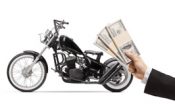Top End Rebuilt and Break-In Procedures
Motorcycle maintenance is key in keeping a motorcycle operating at its peak performance for a long period of time. Just like any other engine, a motorcycle engine needs to be worked on in order for it to operate like new. Engine wear from miles of use will cause metal to breakdown and worn parts create problems. One major problem with motorcycle wear is oil consumption by crank case ventilation slipping by the pistons rings. A piston ring is spring steel designed to keep oil out of the combustion chamber and compression in the chamber. These piston rings become so worn that their sealing properties are compromised and the engine begins to perform poorly. Oil leaking into the combustion chamber will cause the bike to burn oil and to smoke. Oil can also leak into the combustion chamber through leaky valves.
To determine if the bike needs a top end refreshing is usually established by the number of miles on the engine. The manufacturer will have a suggested timeline of when parts need to be replaced or machined. This timeline can change depending on how hard the engine was worked or if it was properly maintained (oil changed regularly, adjustments periodically made, etc.). Oil may seep from base cylinder gaskets and failed head gaskets will definitely need to be changed. For a water-cooled motorcycle, milky oil is a definite sign of a failed head gasket. Oil becomes milky when coolant leaks into and contaminates the oil. Failing valve seals will also cause oil contamination and combustion loss because the head of the valve is not seating properly against its seal. A compression test can determine if both piston rings and valves are failing.
Drain the engine oil from a warmed up engine. Be aware that overhead cam and pushrod engines dissemble differently. A timing chain in an overhead cam arrangement can be tricky if it is not properly taken apart. Some special tools may be needed to dissemble the top half of an engine – refer to the manufacturer’s service manual for this information. Intakes, throttle bodies, carburetors and various other parts of the bike may need to be removed to gain access to the engine. Remove the rocker covers, timing chain, pushrods, pushrod tubes, cylinder heads, cylinder jugs and piston rings. All the seals and gaskets should be scraped off and the metal should be cleaned. Valves, springs, seals and retainers should be removed from the cylinder head. All carbon should be cleaned from the pistons and combustion chamber. Cylinder walls should be checked for gaps and grooves. If they are present, the cylinder wall will need to be machined and oversized pistons will need to be used. If no bad groove is present, they will need to be honed with a cross-hatch. This is done with a hone on a drill in a forward and backward motion to create a cross hatching.
This site and articles contained herein are provided for general informational purposes only and are not a substitute or intended as professional advice. Please be sure to refer to your owner’s manual or consult a mechanic for information specific to your motorcycle. The information contained on this site and articles contained herein are provided on an “as is” basis with no guarantees of completeness, accuracy, usefulness or timeliness and without any warranties of any kind whatsoever, express or implied. Rider Insurance Company and its affiliates (together, “Rider”) assume no responsibility for any errors or omissions in the content of this site and articles contained herein. Any action taken upon this information is strictly at your own risk and Rider will not be liable for any losses or damages in connection with your use of this site and articles. Additional terms and conditions apply and are available at https://www.rider.com/plymouth-rock-assurance-general-terms-and-conditions/.

Piston rings will need to be replaced. They should be fitted with the proper clearance as per the manufacturer. If they are too tight, they will need to be ground down using a special grinding disc. Once proper clearance is obtained, the piston can be fitted into the cylinder using a ring compressor. Base gaskets will need to be replaced if the cylinder jug is removable. Use some lubricant to help with the break in process of the piston rings.
The cylinder heads should be rebuilt with new valves, valve seals, retainers and valve guides. If the valve seat has been distorted due to heat, the valve seat will need to be ground. This can be done by a machinist. It requires a three angle valve grind. Using valve compound, each valve will be lapped in place and then the seals, springs and retainers can be reinstalled. Stainless valves and hardened valve seats work best with today’s gas.
The cylinder head will be installed with a new head gasket and torqued to its proper specifications. Copper head gaskets should be annealed before installed. Pushrod tubes, pushrods, timing chains and cam gears can all be reinstalled and properly adjusted. Valves will need to be adjusted using the valve adjustment sequence in the manufacturer’s service manual. The rocker box is reinstalled and torqued down next. Reinstall the intake, intake seals, throttle body and carburetor systems. Replace the engine oil and add zinc supplements if needed. Install all other necessary parts to make the motorcycle ridable again.
The break-in process is very important. This allows the metal components to wear against each other and create the perfect seal. If done incorrectly, piston rings may never fully seat or the valves may leak. This is also important when installing a new camshaft. For the break-in the process, it is very important to run the bike with a load on it. The best way to do this is to ride the motorcycle. The motorcycle should be warmed up to operating temperature. This is very important – do not ride the motorcycle as soon as it starts. Beating on the motorcycle is not a good idea; it should be taken through the gears at moderate RPM’s. No burnouts should be attempted during the break-in period. The cross hatches on the cylinder walls act like a file to grind the piston rings to conform to the shape of the cylinder. This allows for a tight oil and compression seal. After 20 miles or so, the engine oil should be dumped and replaced. Little metal shavings may appear in the oil. This is an important reason to change the oil.
Once the engine has been put through heat cycles, the pistons should seat and the break-in process should be complete. However if excessive oil is being burned or exhaust gases are leaking from the intake, the rings most likely failed to seat and the whole process of replacing the rings and cross hatching will have to be repeated. Also, once the engine has gone through its heat cycles, all bolts should be re-torqued. Timing and valve adjustments may be necessary to fine tune the engine. Follow all manufacturer’s specifications and enjoy the ride!
Plymouth Rock Assurance is a marketing name used by a group of separate companies that write and manage property and casualty insurance in multiple states. Motorcycle insurance in New Jersey and Pennsylvania is underwritten by Rider Insurance Company. Each company is financially responsible only for its own insurance products. Actual coverage is subject to the language of the policies as issued by each separate company.





